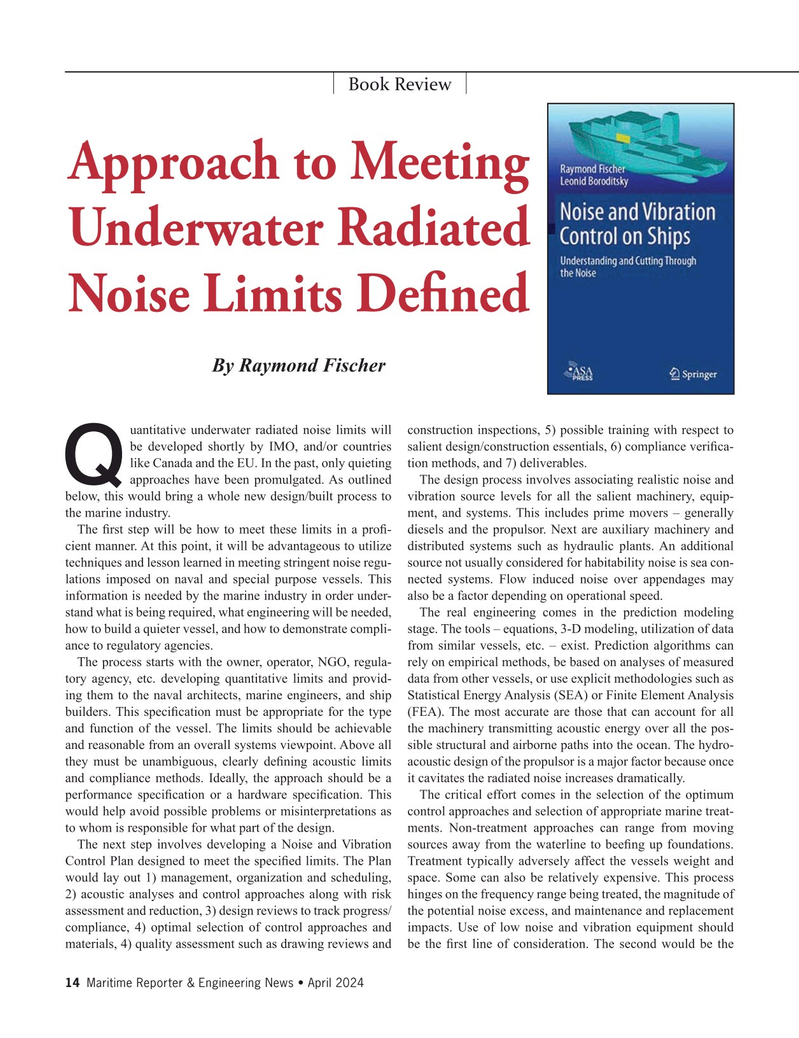
Page 14: of Maritime Reporter Magazine (April 2024)
Read this page in Pdf, Flash or Html5 edition of April 2024 Maritime Reporter Magazine
Book Review
Approach to Meeting
Underwater Radiated
Noise Limits Def ned
By Raymond Fischer uantitative underwater radiated noise limits will construction inspections, 5) possible training with respect to be developed shortly by IMO, and/or countries salient design/construction essentials, 6) compliance veri? ca- like Canada and the EU. In the past, only quieting tion methods, and 7) deliverables.
Q approaches have been promulgated. As outlined The design process involves associating realistic noise and below, this would bring a whole new design/built process to vibration source levels for all the salient machinery, equip- the marine industry. ment, and systems. This includes prime movers – generally
The ? rst step will be how to meet these limits in a pro? - diesels and the propulsor. Next are auxiliary machinery and cient manner. At this point, it will be advantageous to utilize distributed systems such as hydraulic plants. An additional techniques and lesson learned in meeting stringent noise regu- source not usually considered for habitability noise is sea con- lations imposed on naval and special purpose vessels. This nected systems. Flow induced noise over appendages may information is needed by the marine industry in order under- also be a factor depending on operational speed. stand what is being required, what engineering will be needed, The real engineering comes in the prediction modeling how to build a quieter vessel, and how to demonstrate compli- stage. The tools – equations, 3-D modeling, utilization of data ance to regulatory agencies. from similar vessels, etc. – exist. Prediction algorithms can
The process starts with the owner, operator, NGO, regula- rely on empirical methods, be based on analyses of measured tory agency, etc. developing quantitative limits and provid- data from other vessels, or use explicit methodologies such as ing them to the naval architects, marine engineers, and ship Statistical Energy Analysis (SEA) or Finite Element Analysis builders. This speci? cation must be appropriate for the type (FEA). The most accurate are those that can account for all and function of the vessel. The limits should be achievable the machinery transmitting acoustic energy over all the pos- and reasonable from an overall systems viewpoint. Above all sible structural and airborne paths into the ocean. The hydro- they must be unambiguous, clearly de? ning acoustic limits acoustic design of the propulsor is a major factor because once and compliance methods. Ideally, the approach should be a it cavitates the radiated noise increases dramatically. performance speci? cation or a hardware speci? cation. This The critical effort comes in the selection of the optimum would help avoid possible problems or misinterpretations as control approaches and selection of appropriate marine treat- to whom is responsible for what part of the design. ments. Non-treatment approaches can range from moving
The next step involves developing a Noise and Vibration sources away from the waterline to bee? ng up foundations.
Control Plan designed to meet the speci? ed limits. The Plan Treatment typically adversely affect the vessels weight and would lay out 1) management, organization and scheduling, space. Some can also be relatively expensive. This process 2) acoustic analyses and control approaches along with risk hinges on the frequency range being treated, the magnitude of assessment and reduction, 3) design reviews to track progress/ the potential noise excess, and maintenance and replacement compliance, 4) optimal selection of control approaches and impacts. Use of low noise and vibration equipment should materials, 4) quality assessment such as drawing reviews and be the ? rst line of consideration. The second would be the 14 Maritime Reporter & Engineering News • April 2024
MR #4 (1-17).indd 14 4/5/2024 8:39:25 AM

 13
13

 15
15
